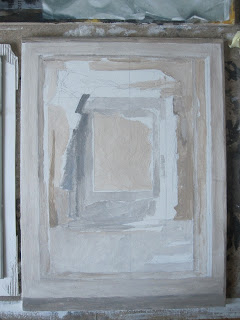Drawing from the live moving model you become aware of how the drawn gestural mark begins, grows, fades and ends in a split second of observation as the model adopts new poses that evolve from previous ones. This process of looking and drawing becomes 'accumulative' and one starts to anticipate and predict the rise and fall of a movement before, during and after making the mark on the paper in sort of inverse cinematic way, turning the flow of movement back into fragmentary still images. At first the mind resists this constant change, wanting the image to be still so it can capture the gesture of the model in the mark but strangely as you get used to the process of intense concentrated looking and drawing the pencil begins to 'dance' and moves on the paper in synchronisation with the movement of the model,going, as it were, 'with the flow' letting go and accepting the constant changes as much as holding on to and trying to capture a frozen moment.
This seems very like observing the breath in breathing meditation (anapanasati) - you cannot hold the breath in order to observe it but can watch it arise and fall naturally, each inhalation and exhalation conditioning the next in continuous cycles.
" First we contemplate just the breath until we see that it is impermanent. We observe that the breath changes and becomes long. Its long duration is impermanent, always changing, getting long and shorter. Its shortness is impermanent as well. The various conditions and characteristics of the breath are impermanent. "
Page 92 'Mindfulness of breathing' ( a manual for serious beginners) Buddhadasa Bhikkhu
I am drawing flowers from observation at the moment in various stages of growth and decay by working on top of and over earlier stages of observation and layers of drawing with various media. I am trying to explore how the drawing itself can 'breath' or 'respire' as the subject changes shape and moves in the various stages of its cycle and the forms and spaces alter and change. Not sure how to know when the drawing is finished but plan to work on several of these drawings as I explore this approach.
I am also reading 'The Great Image Has No Form, or On the Nonobject through Painting¨ by Francois Jullien (translated by Jane Marie Todd) and am finding lots of suggested relationships in this text between drawing and painting in traditional Chinese painting as described by the author and insight from traditional Buddhist meditation although the writer quotes the Laozi and Zhuangzi as the great Taoist texts and philosophies that were informing many of the seminal Chinese landscape painters of the Sung dynasty. One of the key figures, the painter/poet Wang Wei, was a practising Buddhist.
Here is an example to do with 'breath-resonance'
"Instead of categorically setting up presence and absence as opposites, expiration and inspiration govern each other and indefinitely allow passage. The disappearing -reappearing path in Chinese painting, far from serving to construct the painting's perpective by designating a vanishing line by virtue of which progressive and proportional diminution of objects would be rendered, serves rather to unfurl the landscape in continuous renewal"
Page 11 'Presence-Absence ' 'The Great Image Has No Form, or On the Nonobject through Painting¨ by Francois Jullien (translated by Jane Marie Todd)
What is the relationship between the practising art and meditation, between Dhamma and Painting? Perhaps it has to do with trying to actively understand how we perceive and construct 'realities' in worlds and images.
Ajahn Amaro the current abbot of Amaravarti Buddhist Monastery in England says this or something very similar in a recent podcast. I apologise for any inaccuracies.
"We don't experience the world, we experience our minds representation of the world which is not to say there is no real world."
and this from the Dhammapada translated by Juan Mascaro,
" What we are today comes from our thoughts of yesterday; and our present thoughts build our life of tomorrow; our life is the creation of the mind. "
The work in progress below in acrylic under-painting represents the stages so far of a new painting. The problem is how to keep the fresh, lightness of touch and the sketch-like painterly unfinished quality when the work is either finished or abandoned ?










No comments:
Post a Comment